#neolithic road
Explore tagged Tumblr posts
Text
NEOLITHIC WOODEN ROAD
CARRETERA NEOLÍTICA DE MADERA
STRADA NEOLITICA IN LEGNO

(English / Español / Italiano)
In the 1980s, archaeologists discovered a remarkable Neolithic wooden road near Nieuw-Dordrecht in the Netherlands. This ancient peat road, dating back an impressive 4,573 years, stretches for at least 800 metres. Through the meticulous science of dendrochronology, or tree-ring dating, experts have identified its construction to 2549 BC.
This discovery not only highlights the advanced engineering skills of Neolithic communities, but also offers invaluable insights into their transport and trade practices. The preservation of the road in the peat bogs has provided a rare insight into the sophisticated infrastructure of prehistoric Europe.
-----------------------------------------------------------------------------
En la década de 1980, los arqueólogos descubrieron una notable carretera de madera neolítica cerca de Nieuw-Dordrecht en los Países Bajos. Este antiguo camino de turba, que data de unos impresionantes 4.573 años, se extiende por al menos 800 metros. A través de la meticulosa ciencia de la dendrocronología, o datación de anillos de árboles, los expertos han identificado su construcción al 2549 a. C.
Este descubrimiento no sólo destaca las avanzadas habilidades de ingeniería de las comunidades neolíticas, sino que también ofrece inestimables ideas sobre sus prácticas de transporte y comercio. La preservación de la carretera en los pantanos de turba ha permitido una rara visión de la sofisticada infraestructura de la Europa prehistórica.
-----------------------------------------------------------------------------
Negli anni '80, gli archeologi hanno scoperto una straordinaria strada di legno neolitica nei pressi di Nieuw-Dordrecht, nei Paesi Bassi. Questa antica strada di torba, risalente a ben 4.573 anni fa, si estende per almeno 800 metri. Grazie alla meticolosa scienza della dendrocronologia, o datazione degli anelli degli alberi, gli esperti hanno identificato la sua costruzione nel 2549 a.C..
Questa scoperta non solo evidenzia le avanzate capacità ingegneristiche delle comunità neolitiche, ma offre anche preziose indicazioni sulle loro pratiche di trasporto e commercio. La conservazione della strada nelle torbiere ha fornito una rara visione delle sofisticate infrastrutture dell'Europa preistorica.
6 notes
·
View notes
Text
That's a pretty well-made road.
#ancient Croatia#Neolithic period#submerged road#archaeology#underwater archaeology#marine archaeology
15 notes
·
View notes
Text
Please check out our Patreon! You'll get chapters of my webnovels as well as updates on the upcoming games!
#game inspo#game dev#game writing#game design#game developers#game development#indie game#indie game dev#indiedev#indiegamedev#indie games#interactive fiction#if#writeblr#writblr#writers on tumblr#writing#creative writing#fiction#webnovel reccomendations#royal road#TTBTP#Transmigrator Turned Beast Tamer Princess#isekai#cultivator#xianxia#polyamorous#lgbtq+#stone age#neolithic
1 note
·
View note
Text






Scotland (2) (3) (4) (5) (6) by Tobias Verfuss
Via Flickr:
(1) Dunnottar Castle, a ruined 15th and 16th century castle near Stonehaven (2) Rosebay willowherb (3) Stromness harbour (4) Cliffs at Marwick Head, Orkney (5) Neolithic henge and stone circle, the Ring of Brodgar, near Stromness (6) Lonely telephone box at a countryside road in Orkney
#castle#ruins#ocean#wide sky#cliffs#flowers#rosebay willowherb#fireweed#harbor#neolithic henge#road stretching out#scotland#orkney
1 note
·
View note
Text
Previous excavations at Soline have found the remains of preserved organic materials which have been carbon dated to around 4,900 years-ago.
A recent underwater survey of the site has revealed a four-metre-wide linear road built with stone slabs, which the researchers suggest dates from almost 7,000-years-ago.
0 notes
Text
A system of ancient ceramic water pipes, the oldest ever unearthed in China, shows that neolithic people were capable of complex engineering feats without the need for a centralized state authority, finds a new study by University College London researchers. In a study published in Nature Water, the archaeological team describe a network of ceramic water pipes and drainage ditches at the Chinese walled site of Pingliangtai dating back 4,000 years to a time known as the Longshan period. The network shows cooperation among the community to build and maintain the drainage system, though no evidence of a centralized power or authority. Dr. Yijie Zhuang (UCL Institute of Archaeology), senior and corresponding author on the paper, said, "The discovery of this ceramic water pipe network is remarkable because the people of Pingliangtai were able to build and maintain this advanced water management system with stone age tools and without the organization of a central power structure. This system would have required a significant level of community-wide planning and coordination, and it was all done communally." The ceramic water pipes make up a drainage system which is the oldest complete system ever discovered in China. Made by interconnecting individual segments, the water pipes run along roads and walls to divert rainwater and show an advanced level of central planning at the neolithic site. What's surprising to researchers is that the settlement of Pingliangtai shows little evidence of social hierarchy. Its houses were uniformly small and show no signs of social stratification or significant inequality among the population. Excavations at the town's cemetery likewise found no evidence of a social hierarchy in burials, a marked difference from excavations at other nearby towns of the same era. But, despite the apparent lack of a centralized authority, the town's population came together and undertook the careful coordination needed to produce the ceramic pipes, plan their layout, install and maintain them, a project which likely took a great deal of effort from much of the community. The level of complexity associated with these pipes refutes an earlier understanding in archaeological fields that holds that only a centralized state power with governing elites would be able to muster the organization and resources to build a complex water management system. While other ancient societies with advanced water systems tended to have a stronger, more centralized governance, or even despotism, Pingliangtai demonstrates that was not always needed, and more egalitarian and communal societies were capable of these kinds of engineering feats as well.
991 notes
·
View notes
Text
My thoughts on the Just Stop Oil publicity stunt at Stonehenge, as someone who worked there, an archaeologist and a pagan: I'm massively annoyed.
Not at JSO actually. At the hypocrisy I'm seeing everywhere.
I'm angry at the politicians who haven't said a word about the A303 tunnel that is going to do irreparable damage to the site and the archaeology. (don't get me wrong, I know a lot of the archaeologists who will be on the project, I have every faith in them, but it is a commercial venture, limited by time, budget and frankly just the techniques available to us now). It's going to be really bad for the environment.
I'm also annoyed at the online pagan community. I've seen so many neo pagans/wiccans with the most surface level "they've made an enemy of their closest allies" take. Well, we can see that you don't actually care about the environment if that's all it takes to turn you away from this. Closing a road would have created environmental damage from all the cars hanging around for hours! Also, where have they been in the campaign against the A303?
Or the fact that Salisbury Plain is being eaten up by new build housing estates that don't support the needs of the residents and stresses local services. Because Stonehenge is just the most famous archaeological monument on the Plain but there are tens, if not hundreds of sites that are being lost. I have literally worked on one- a Bronze Age barrow cemetery with several ring ditches, a potential Neolithic god-pole like structure, Iron Age, Roman and Anglo-Saxon settlement evidence. All destroyed by a new build estate that cannot be supported by local infrastructure, literally in terms of the roads.
They're also the sort of people who complain about the cost of Stonehenge. There is a very good reason that it's so expensive- it basically funds a significant chunk of Historic England (which is far more than just the monuments and sites you can visit). Many of HE's sites are free and they still need to be maintained, which is incredibly expensive. And they're the sort of people to culturally appropriate from other cultures, rather than looking to the archaeology they're fake outraged by.
The paint was made out of cornflour, so not actually a huge conservation issue (I mean, it would definitely better to have not happened but honestly probably the least worst option). The damage done by smog and other air pollution is significantly worse.
People should be angry that this is what people are being forced to do to have their voices heard.
#they speak#archaeology#just stop oil#stonehenge#climate change#history#heritage sites#pagan#paganism#i even saw a video from a woman who called it a bronze time site :/#if you can't even get the most basic facts right dont talk on the topic istg#climate issues
138 notes
·
View notes
Text
Problematic and Bigoted Pagan Authors (and how to avoid them)
After what was pretty much a mess in a discord server I'm in over an author posting artwork containing Nazi symbols, I decided to make a post letting everyone know about certain authors and what to look out for. I will keep updating this list as I discover things!
Big thanks to @dvudushnydiaries for letting me know ab some Slavic Polytheist authors, as well as my friend Agnes for letting me know about some Irish Polytheist Authors too! <3
If you have any suggestions to add to this list, please let me know!!!
🛑 = Avoid as much as possible
⚠️ = Be very cautious around this author
Generally, here is some red flags to look out for:
Use of symbols associated with hate groups
Claims an (open culture) is closed via ethnicity, especially if these cultures or religions historically shared with other cultures.
Claims there is a "true" or "pure" version of a certain open religion.
Use of dogwhistles.
Writes historical inaccuracies, misinformation, appropriation, making up things and presenting them as fact, etc.
Refusal to take accountability for actions.
Any form of bigotry or discrimination
The list is under the cut!
Hellenic Polytheist Authors
🛑 Timothy Jay Alexander
creator of the "Pillars of Hellenismos", which have little historical basis.
Made homophobic and ableist remarks in a blog post, essentially saying that because ancient Greece did not allow same-sex marriage, that modern Hellenic Polytheists shouldn't too. In this same post he said that marriage should be for making a family, and that since LGBTQ+ people, as well as people with "physical deformities" either can not or should not have children, they cannot marry according to him.
The same ableist remarks listed above were used as reasoning as to why a disabled person shouldn't become a priest or priestess or any higher up positions due to not being in good health. This also reminds me of eugenics.
In that same blog post, referenced a group called YSEE, which is notorious for being homophobic, xenophobic, displaying nationalism among other things better explained in this post by @hellenic-reconstructionism
Books include: A Beginner’s Guide to Hellenismos - Hellenismos Today - The Gods of Reason: An Authentic Theology for Modern Hellenismos
🛑 Galina Krasskova
Numerous things have happened with this author, some of the most notable being selling "Bacchic Lives Matter" pins on Etsy during the 2020 Black Lives Matter movement protests, as well as defending a neo-nazi and fascist group, AFA, on a blog post
Some of her Hellenic Polytheist books include: Honoring the Mothers: Novenas to the Mothers of Our Gods and Heroes - Combatting the Evil Eye - Unto Herself: A Devotional Anthology for Independent Goddesses - Out of Arcadia: A Devotional Anthology in Honor of Pan - Guardian of the Road: A Devotional Anthology in Honor of Hermes
See Norse Polytheist section for her books on that.
🛑 Edward P. Butler
Supports Hindutva, which is Hindu fascism, antisemitic, as well as defends and supports Galina Krasskova.
Books include: Essays on a Polytheistic Philosophy of Religion - Essays on Hellenic Theology.
🛑 H. Jeremiah Lewis / Sannion
Neo-nazi, having nazi symbols on his blog. Also transphobic, islamophobic, and everything under the sun, really.
Books include: Ecstatic: For Dionysos - End to End - Everything Dances: Strange Spirits 3 - Gods and Mortals: New Stories of Hellenic Polytheism
Norse Polytheist Authors
🛑 Galina Krasskova
See Hellenic Polytheist section for details.
Her Norse Polytheist books include: Living Runes; Theory and Practice of Norse Divination - Northern Tradition for the Solitary Practitioner - Neolithic Shamanism; Spirit Work in the Norse Tradition
Irish Polytheist Authors
⚠️ Lora O'Brien
Has a cultish following, thier followers and even themselves bullying and publicly shaming other Irish Polytheists. Often acts negatively towards the Irish diaspora. Has taught Irish Catholic practices, which are closed.
Runs the Irish Pagan School, which has similar rhetoric.
Books include: Irish Witchcraft from an Irish Witch - A Practical Guide to Pagan Priesthood
Slavic Polytheist Authors
🛑 Patricia Woodruff
Has a cultish following, often writes wildly inaccurate information. In a recent book she had completely made up a deity whose name means "swastika". Rated her own books on Goodreads, and publicly responded to any reviews criticizing her books.
Books include: Woodruff's Guide to Slavic Deities - Roots of Slavic Magic Book 1: Slavic Deities & Their Worship
🛑 Madame Pamita
Recently had a (now-deleted) post with an artwork containing various Nazi symbols, and deleted any criticism and seemingly refused to take any accountability. In DM's had repeatedly alluded to if you didn't follow her you "didn't know anything about Slavic Polytheism". Said to be friends with Patricia Woodruff
Books include: The Book of Candle Magic, Baba Yaga's Book of Witchcraft
🛑 Dmitriy Kushnir
Writes about Rodnovery, which many Rodnovery groups in the US and other countries often have ethnonationalist and right-wing connotations and ideology.
Books include: Rodnover
⚠️ Natasha Helvin
Misconstrues Slavic culture to be Wiccan
Says witchcraft are the "universal laws of nature" and that subjects of karma and divine judgement are solely monotheistic.
Claims to be an initiated Haitian Vodou priestess, which is doubtful.
Kemetic Polytheist Authors
⚠️ E. A Wallis Budge
Inaccurate translations of texts
Books include: The Egyptian Book of the Dead (Translation)
#hellenic pagan#hellenic polytheism#psa#pagan#irish polytheism#slavic polytheism#kemetic polytheism#norse polytheism
74 notes
·
View notes
Text
The Hound of the Baskervilles: The Stapletons of Merripit House
A mullion is a vertical divider in a window.
A scullery maid was the lowest ranking female servant in the household, who would wash the dishes and sometimes the clothing too. Snow White and Cinderella started off in this role.
It would take Watson around two hours to walk to Grimpen. I've done longer walks and I suppose he would have done so in his Army days.
A grocer is a person who runs a grocery, which in British English is analagous to a general store, where you would buy most everyday items, including the most common newspapers and magazines. We would also distinguish these days between the larger supermarket (grocery store) and the smaller corner shop (what New Yorkers would call a bodega); frequently run by immigrants or their immediate descendants. This is an example of the latter.
I do not know how common it was then, but today it is very common, even in major cities, to have a Post Office counter as part of another store such as a corner shop; these franchised businesses are run by subpostmasters. The Post Office, as well as post, provides banking services for both its own financial business and for other banks or building societies. The computer system that was used for financial transactions by them, Horizon, is currently at the centre of a major scandal.
Dartmoor has many peat bogs. The Ordnance Survey maps give their general location, but their exact size varies depending on conditions. Walkers frequently end up in them by accident or lack of experience; safe routes are marked out, but not always easy to see. The vast majority are not that deep and the worst that will happen is a case of smelly, muddy embarrassment. However, some are deeper, where you can end up with a risk of hypothermia - there are no less than four volunteer Mountain Rescue teams in the area to help people in difficulty.
Then some are straight up lethal, especially to animals. A gallop is the fastest horse speed setting - a horse can run at around 25 to 30mph for up to three kilometres before getting winded. So, not a good idea to do it on boggy land.
Grimpen Mire is believed to have been inspired by Fox Tor Mire:
There are 14 species of bittern. One of them is the Eurasian bittern, which was indeed extinct in the UK for a while when this story takes place and is still only here in limited numbers with its habitat. The species as a whole currently rated "Least Concern" but in decline.
youtube
The Neolithic period lasted from c.10,000 BC to c.2,000 BC, being the final period of the Stone Age. There is a timber track pathway in Somerset, the oldest recorded road, dating back to c. 3,838 BC.
Cyclopides was an old name for several species of South African Skipper butterflies. They tend to be found in southern Africa, not Dartmoor:
Miss Stapleton must deem the situation urgent to leave without her hat; people did not as a general rule go hatless in this period, even the poorest usually had some form of cap.
24 notes
·
View notes
Note
Heeyyy so I did ask a question about Captain Goodarm and tagged you in it but I don't think you saw so I decided to ask again in this thingy (no I'm not trying to rush you I'm just making sure you see the question you can answer anytime you want).
ANYWAYSSYSSSY I'm very interested in Captain Goodarm and I would like to know more about his personality :3
Goodarm considers himself the most level headed and mature of the other pirate captain, emphasis on considers.
Truthfully, he is prone to losing himself to his ego, pride, and temper just as the others, but at the very least tries to rise above it (take the high road and all that). Because in the way Pike is considered much opposite to her former captain, Goodarm is the same.
Captain Tremor was the most reckless and abrasive of the pirate captains during the golden age of piracy, letting his hubris and conceit get the better of him, something Goodarm vowed to avoid as it was his captain's downfall.
Goodarm was originally an astronomy teacher, but during a class trip, his ship was hijacked and destroyed by poachers, all of his students being lost to the attack or taken prisoner, with only Goodarm left behind and presumed dead before he was rescued by Captain Tremor. His knowledge of the Etherium's space made him for a viable navigator, and also having the capability to read and write, he was considered a great asset to the crew.
He has a soft spot for younger ones; and despite his criticisms of them, he also cares about Haggis and Pike-- but he never misses an opportunity to outclass them as there are many rumors/bets that Goodarm will be the first to die of the "Neolithic" captains
#for future reference i'm prone to missing questions if you only @ me in a post!#as it will get lost in my notifs feed after a while#im more likely to answer/see it if you just send it to my ask box#that way i dont lose track of it ✌🏻#the tales of nathaniel flint
15 notes
·
View notes
Photo

Silk in Antiquity
Silk is a fabric first produced in Neolithic China from the filaments of the cocoon of the silk worm. It became a staple source of income for small farmers and, as weaving techniques improved, the reputation of Chinese silk spread so that it became highly desired across the empires of the ancient world. As China's most important export for much of its history, the material gave its name to the great trading network the Silk Road, which connected East Asia to Europe, India, and Africa. Not only used to make fine clothes, silk was used for fans, wall hangings, banners, and as a popular alternative to paper for writers and artists.
Origins & Cultivation
Silk is produced by silk worms (Bombyx mori) to form the cocoon within which the larvae develop. A single specimen is capable of producing a 0.025 mm thick thread over 900 metres (3,000 ft) long. Several such filaments are then twisted together to make a thread thick enough to be used to weave material. Fabrics were created using looms, and treadle-operated versions appear in, for example, the murals in tombs of the Han dynasty (206 BCE - 220 CE). The silk could be dyed and painted using such minerals and natural materials as cinnabar, red ochre, powdered silver, powdered clam shells, and indigo and other inks extracted from vegetable matter.
Sericulture - that is the cultivation of mulberry leaves, the tending of silkworms, the gathering of threads from their cocoons and the weaving of silk - first appears in the archaeological record of ancient China c. 3600 BCE. Excavations at Hemudu in Zhejiang province have revealed Neolithic tools for weaving and silk gauze. The earliest known examples of woven silk date to c. 2700 BCE and come from the site of Qianshanyang, also in Zhejiang. Recent archaeological evidence suggests that the Indus Valley civilization in the north of the Indian subcontinent was also making silk contemporary with the Neolithic Chinese. They used the Antheraea moth to produce silk threads for weaving.
However, silk production on a large scale and involving more sophisticated weaving techniques would only appear from the Chinese Shang and Zhou dynasties in the 2nd millennium BCE. Silk then became one of the most important manufactured and traded goods in ancient China, and finds of Shang dynasty (c. 1600 - 1046 BCE) silk in an Egyptian tomb are testimony to its esteemed value and use in early international trade.
Continue reading...
31 notes
·
View notes
Text

A 4,573-year-old neolithic wooden peat road near Nieuw-Dordrecht, in the Netherlands, excavated in the 1980s. The peat road was at least 800 metres long, and its construction has been precisely dated to the year 2,549 BC thanks to dendrochronology or tree-ring dating
35 notes
·
View notes
Text
Ok y’all ima ‘bout to lay some heavy truth on you…
This is all taken from “The Dawn of Everything” by Graeber and Wengrow.
What [Neolithic ecology] really seems to have been about is creating garden plots - artificial, often temporary habitats - in which the ecological scales were tipped in favour of preferred species… Theirs was not a science of domination and classification, but one of bending and coaxing, nurturing and cajoling, or even tricking the forces of nature, to increase the likelihood of securing a favourable outcome.
The authors elaborate on archaeological evidence that points to much of this early “experimental farming” work being conducted by women. 👇🏻
…We find ourselves reminded of Silvia Federici's “Caliban and the Witch” (1998), where she showed how, in Europe, such 'magical' approaches to production came to be associated not just with women but with witchcraft. Federici argues that the elimination of such attitudes was essential for the establishment of modern (male-dominated) science, and also for the growth of capitalist wage labour: ‘This is how we must read the attack against witchcraft and against that magical view of the world which, despite the best efforts of the Church, had continued to prevail on a popular level through the Middle Ages... In this perspective ... every element - herbs, plants, metals, and most of all the human body - hid virtues and powers peculiar to it... From palmistry to divination, from the use of charms to sympathetic healing, magic opened a vast number of possibilities... Eradicating these practices was a necessary condition for the capitalist rationalisation of work, since magic appeared as an illicit form of power and an instrument to obtain what one wanted without work... "Magic kills industry," lamented Francis Bacon, admitting that nothing repelled him so much as the assumption that one could obtain results with a few idle experiments, rather than with the sweat of one's brow.’ (Federici 1998: 142)
…since there was no Eden-like state from which the first farmers could take their first steps on the road to inequality, it makes even less sense to talk about agriculture as marking the origins of social rank, inequality or private property. In the Fertile Crescent, it is - if anything - among upland groups, furthest removed from a dependence on agriculture, that we find stratification and violence becoming entrenched; while their lowland counterparts, who linked the production of crops to important social rituals, come out looking decidedly more egalitarian; and much of this egalitarianism relates to an increase in the economic and social visibility of women, reflected in their art and ritual.
Such a great book! I’m about to get into the part now where we start discovering when and how the notions of industry and private property became so entrenched in Western culture, since it’s become clear that it was not due (at least not in one fell swoop) to the so-called “Agricultural Revolution”.
🤜 🫳🎤
Side note/shameless plug:
How adorbs is this handmade bookmark I’m using from @thegoodekarmaco ?? 🥰

5 notes
·
View notes
Text
Goodbye, Fawn
My brilliant friend Fawn (@esterbrook) died on Friday.
Fawn and I met when I was about 24 and she was about 43, and at the time, foolishly, I thought I was the cool one. I very quickly realised that I was wrong, and that Fawn was who I wanted to be when I grew up.
She was independent, funny, smart, and passionate. If there was anything she didn’t like, she would do something about it—she campaigned for abortion rights and did phone banking for US elections. She was sharp and kind and pragmatic and gave amazing advice.
Fawn loved stories and history—we met on an archaeological training dig in York, and later bonded over fic in the Sherlock fandom—and was forever turning up old letters and pens and other things that she breathed new life into. She found a pen at a flea market and tracked down its original owner; she chronicled a WWII romance from a box of photographs (https://www.tumblr.com/a-certain-party-i-love).
For the past twenty years, Fawn kept a diary that will now be donated to a women’s history library. I hope one day someone devotes as much care to her memory as she did to other people’s.
I find it hard to think of many people who are leaving as big a legacy as Fawn. Her activism, writing (also wrote the first book on surviving at work when you have depression), and (towards the end of her life) participation in a clinical trial have helped so many people directly, and will continue to reverberate.
And she’s still not done: even before she was diagnosed with ALS, she arranged to donate her body to forensic science (and wrote about it here: https://www.nytimes.com/2019/02/28/well/live/my-afterlife-on-the-body-farm.html).
I’m so lucky to have been able to make wonderful memories with Fawn. We went on a road trip in Northumberland and laughed at all the dicks in Chesters Roman fort with her friend Martin, who I would eventually move to Berlin with; she visited us there and baked a derby pie full of bourbon for Friendsgiving. We went to Brittany and got emotional about the Neolithic standing stones at Carnac. We walked all over London and she showed me spots I didn’t even know about despite living there for three years.
In May, I got to visit her in her beloved San Francisco, where she introduced me to tamales, giant redwoods, and her cat Cosmo, successor of Rupert, the fluffiest and most handsome gentleman who accompanied her for most of her last ten years.
We went over and under the Golden Gate bridge, drank many cups of coffee, roamed around the Castro and Haight-Ashbury, waved across the Pacific, browsed bookshops and made sourdough and did laundry and talked until late into the night.
She was diagnosed with ALS less than a year and a half ago, which was the cruellest fucking thing not only because she deserved so much more time on this earth, but because it made talking, eating and living independently—all things she adored—so much more difficult and eventually impossible. She chose to take advantage of California’s aid in dying law and leave on her own terms, because nobody was ever the boss of Fawn, not even death.
Fawn, I miss you already. I always imagined we would one day be old ladies cackling at dirty jokes together, and it’s a crying shame that the world has been robbed of the wicked glint in your eye at least thirty years too early. You changed my life for the better in so many ways, and I still want to be you when I grow up. I love you. Sleep well.
#esterbrook#oh fawn i miss you already#i was so wildly lucky to know her both online and off#she was absolutely brilliant#feels odd not to have written more about our fannish life but i knew her offline first#i’m realising that i may not have read all her fics yet and i now get to do that
36 notes
·
View notes
Text
These are sketches from the first chapter of the lonely flame AU.
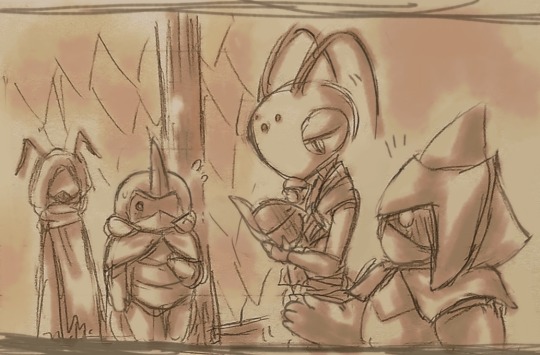
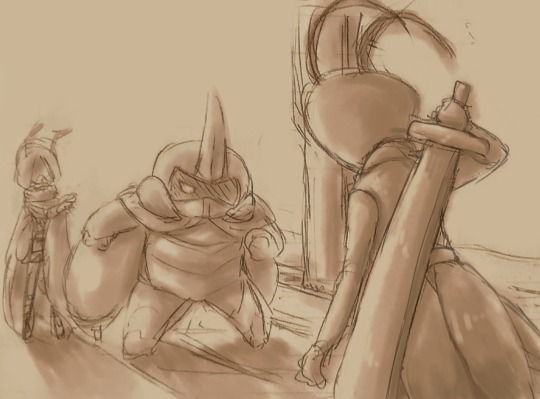
Thanks to a letter of introduction given by Neolith, Kabbu and Hoaxe were able to take Maki's test and become explorers.
As their first assignment, the pair are ordered to scout the area around the entrance to Snakemouth Den.
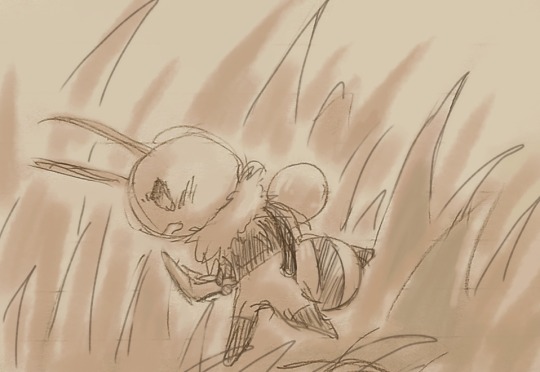
Vi is furious to see two new recruits sent to Snakemouth Den, where she want to go, after being rejected by Eetl to become an explorer.
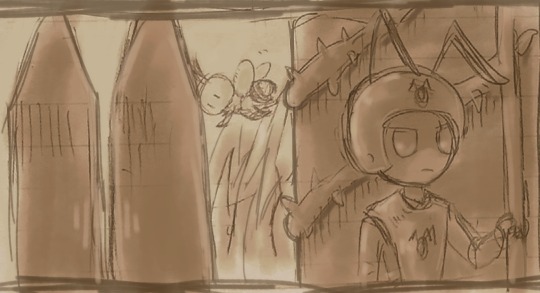
She follows them stealthily.
Those two men don't look very strong. One in particular seemed unable to fight, just giving instructions to the beetles.
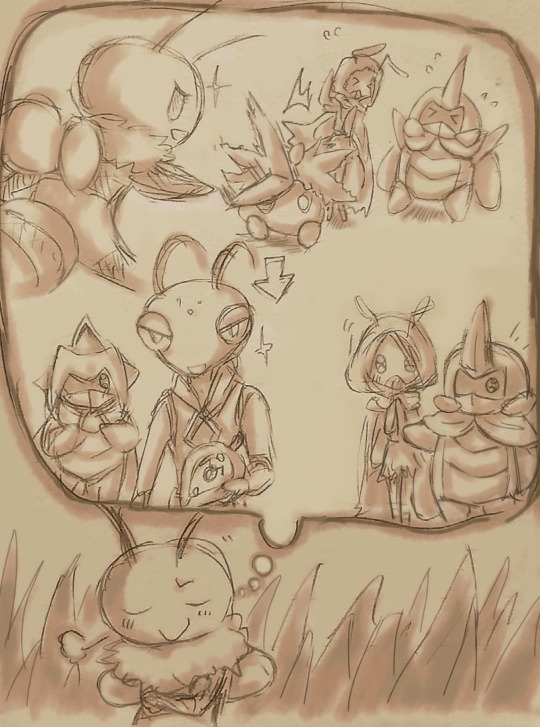
They're bound to struggle... and Vi is there to help them out in a dashing, cool way when they're in danger! Then those two would praise Vi, and Maki would hear about it and approve Vi as an explorer!
Vi did not intend to team up with Kabbu and his team. She wanted to be an explorer on her own, without companions.
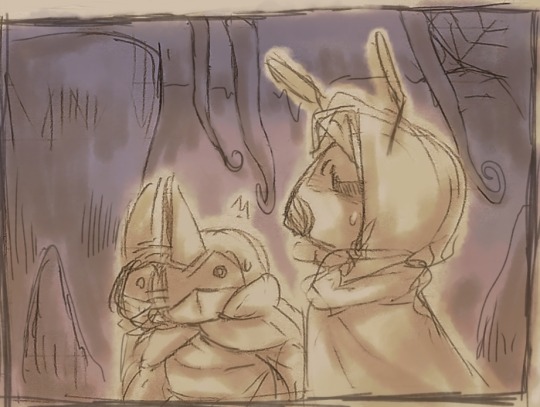
Hoaxe notices that Snakemouth Den is full of traps and that none of these traps are now activated now.
Hoaxe and Kabbu move ahead gradually, being vigilant.
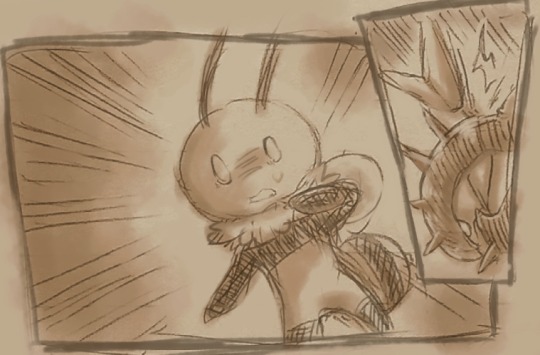
Thanks to their slow steps, Vi was able to catch up with them.
However, Vi encounters inichas on the road and she is injured in the back...
103 notes
·
View notes
Text
A Development Could Kill One of the Oldest Living Things on the Planet. (Sierra Club)

Jurupa oak. | Photos courtesy of Aaron Echols
Excerpt from this story from the Sierra Club:
Few living organisms can claim to be 1,000 years or older. The ones that can are most likely trees. From Methuselah, the Eastern Sierra’s nearly 5,000-year-old bristlecone pine, to Pando, a clonal colony of quaking aspens in Utah more than 14,000 years old, these ancient beings provide a snapshot of our world.
The US Forest Service rightly protects Methuselah and Pando so travelers far and wide can gain perspective on our brief human lifespan and the mark we leave on Earth. Another of these neolithic wonders is an oak between 13,000 and 18,000 years old in California’s Riverside County, but it’s being denied the protection it desperately needs.
The Jurupa oak, an 80-foot-long Palmer’s oak shrub (Quercus palmeri), is one of the oldest living organisms on Earth. This clonal colony sprouted among saber-toothed cats, giant ground sloths, and mammoths during the Pleistocene era. However, the future of the oak is now in peril thanks to a decision by the Jurupa Valley City Council. In September, it narrowly agreed to approve a sprawling 917-acre development. The council voted 3-2 to allow a massive warehouse complex, chain restaurants, salons, and breweries just 450 feet from the oak. It will increase Jurupa Valley’s population by 6 percent, bulldozing more than 200 acres for homes and 140 acres for industrial and business parks.
Despite the dangers to new residents and the surrounding community, developers are planning to build all of this smack dab in the middle of an area east of Los Angeles that’s designated as a high-risk fire hazard severity zone. So why didn’t the Jurupa Valley City Council protect the ancient and enduring Jurupa oak as the Forest Service did Pando and Methuselah? The simple answers are location and money. The oak’s rocky outcrop is in an area gradually being devoured to accommodate our obsession with online shopping. In its place, the city wants to see a vast landscape of warehouses and roads clogged with trucks going back and forth 24/7. In 1980, the Inland Empire, which encompasses Jurupa Valley, had 234 warehouses. Now, there are more than 4,000, covering nearly 26,000 acres of the region. In the eyes of the warehouse industry and the city, the world’s oldest Palmer’s oak—and the last in its watershed—is disposable.
This enduring oak, with its spindly leaves and ancient roots, shouldn’t be thrown away like packaging from an online purchase. But that’s the kind of casual treatment city officials have provided, feigning certainty that nearby development will not harm the oak while admitting they can’t answer lingering questions.
How far do the Jurupa oak’s roots extend, and where does its water come from? How might increased temperatures from fossil-fuel-driven climate change and the urban heat island effect harm the oak? Could heavy machinery vibrations during construction jar loose the rocks supporting the oak’s roots?
These crucial questions need to be answered to ensure a responsible project that protects the Jurupa oak. Unfortunately, the city approved the massive development without answers to any of them, risking death for the world’s third-oldest organism.
That’s why the Center for Biological Diversity and other environmental groups filed a lawsuit under the California Environmental Quality Act seeking a 100-acre preserve to safeguard the oak. This legal fight should not even be necessary. Anyone who has strolled through the ancient bristlecone forest or stood beneath the 3,000-year-old Grizzly Giant Tree in Sequoia National Park understands that the value of these ancient beings far outweighs another Southern California warehouse.
6 notes
·
View notes